tow Citroen C4 2014 2.G Owner's Guide
[x] Cancel search | Manufacturer: CITROEN, Model Year: 2014, Model line: C4, Model: Citroen C4 2014 2.GPages: 340, PDF Size: 28.99 MB
Page 156 of 340

9
DRIVING
154
Immobilise the vehicle (or keep
it stationary, if the brake pedal is
pressed), with the engine running,
by engaging fi rst gear (manual
gearbox) or position M
or R
(elec-
tronic gearbox).
Switch off the engine but leave the
ignition on. If it is not possible to im-
mobilise the vehicle, do not operate
the control and contact a CITROËN
dealer or a qualifi ed workshop with-
out delay.
Immobilise the vehicle by placing
the blocks in front or behind the two
front wheels, opposite to the direc-
tion of the slope.
For safety reasons, after this op-
eration it is essential to contact
a CITROËN dealer or a qualifi ed
workshop without delay to re-
place the protective cover.
Following an emergency unlock-
ing, immobilisation of the vehicle
is no longer assured once the
manual emergency release has
been deployed and the manual
control does not allow the re-ap-
plication of your parking brake.
Take no action, either on the
control lever A
, or stopping start-
ing the engine while the release
crank is engaged.
Take care not to allow moisture
or dust in the proximity of the
protective cover.
Remove the storage box under the
boot carpet for access to the emer-
gency release device.
Pierce the protective cover D
on the
tube E
with the release crank.
Introduce the release crank into the
tube.
Turn the release device clockwise .
For safety reasons
, it is essential
to continue turning the device until it
reaches its stop. The parking brake
is released.
Remove the release crank and stow
it with the chocks in the storage box
under the boot carpet.
- Switch the ignition off and then on
to reinitialise the parking brake. If
the reinitialisation of the parking
brake proves impossible, contact
a CITROËN dealer or a qualifi ed
workshop.
- The subsequent time required for
application may be longer than dur-
ing normal operation.
Page 165 of 340

9
DRIVING
163
Manual operation
Select position M
for sequential
changing of the six gears.
Push the lever towards the +
sign to
change up a gear.
Pull the lever towards the -
sign to
change down a gear.
It is only possible to change from one
gear to another if the vehicle speed and
engine speed permit; otherwise, the
gearbox will operate temporarily in au-
tomatic mode.
D
disappears and the gears
engaged appear in succes-
sion in the instrument panel.
If the engine speed is too low
or too high, the gear selected
fl ashes for a few seconds, then the ac-
tual gear engaged is displayed.
It is possible to change from position D
(automatic) to position M
(manual) at
any time.
When the vehicle is stationary or mov-
ing very slowly, the gearbox selects
gear M1
automatically.
The sport and snow programmes do
not operate in manual mode.
Invalid value during manual
operation
This symbol is displayed if a
gear is not engaged correctly
(selector between two posi-
tions).
Stopping the vehicle
Before switching off the engine, you
can engage position P
or N
to place the
gearbox in neutral.
In both cases, apply the parking brake
to immobilise the vehicle, unless it is
programmed to automatic mode.
If the lever is not in position P
,
when the driver's door is opened
or approximately 45 seconds
after the ignition is switched off,
there is an audible signal and a
message appears.
Return the lever to position P
;
the audible signal stops and
the message disappears.
You risk damaging the gearbox:
- if you press the accelera-
tor and brake pedals at the
same time,
- if you force the lever from
position P
to another position
when the battery is fl at. When the ignition is on,
the lighting of this warning
lamp, accompanied by an
audible signal and a message in the
multifunction screen, indicates a gear-
box malfunction.
In this case, the gearbox switches to
back-up mode and is locked in 3rd gear.
You may feel a substantial knock when
changing from P
to R
and from N
to R
.
This will not cause any damage to the
gearbox.
Do not exceed 60 mph (100 km/h), lo-
cal speed restrictions permitting.
Have it checked by a CITROËN dealer
or a qualifi ed workshop.
This warning lamp may also come on if
a door is opened.
Operating fault
To reduce fuel consumption
when stationary for long periods
with the engine running (traffi c
jam...), position the gear lever
at N
and apply the parking brake,
unless it is programmed in auto-
matic mode.
Page 176 of 340
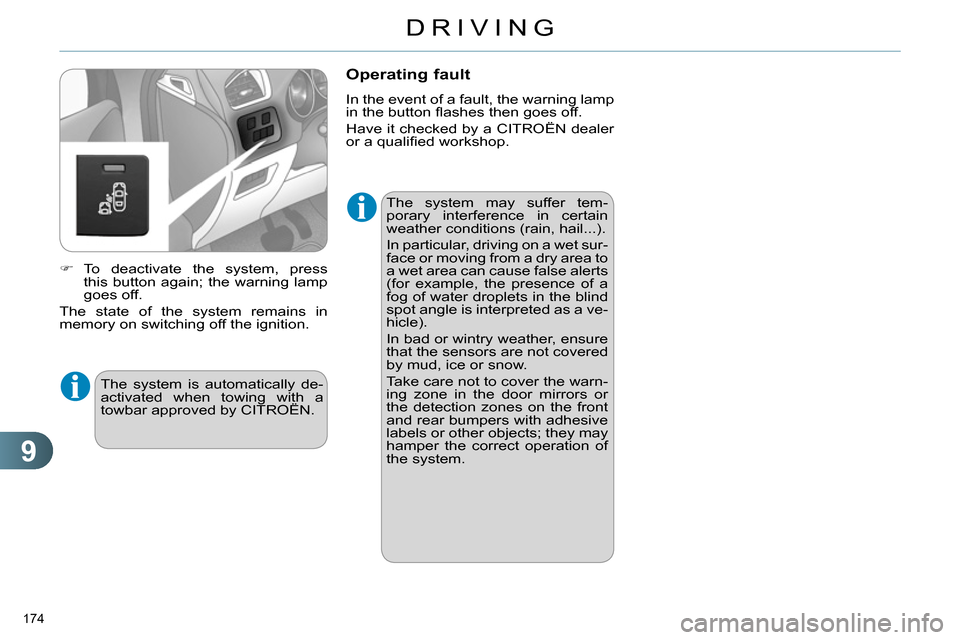
9
DRIVING
174
The system may suffer tem-
porary interference in certain
weather conditions (rain, hail...).
In particular, driving on a wet sur-
face or moving from a dry area to
a wet area can cause false alerts
(for example, the presence of a
fog of water droplets in the blind
spot angle is interpreted as a ve-
hicle).
In bad or wintry weather, ensure
that the sensors are not covered
by mud, ice or snow.
Take care not to cover the warn-
ing zone in the door mirrors or
the detection zones on the front
and rear bumpers with adhesive
labels or other objects; they may
hamper the correct operation of
the system.
To deactivate the system, press
this button again; the warning lamp
goes off.
The state of the system remains in
memory on switching off the ignition.
Operating fault
In the event of a fault, the warning lamp
in the button fl ashes then goes off.
Have it checked by a CITROËN dealer
or a qualifi ed workshop.
The system is automatically de-
activated when towing with a
towbar approved by CITROËN.
Page 181 of 340
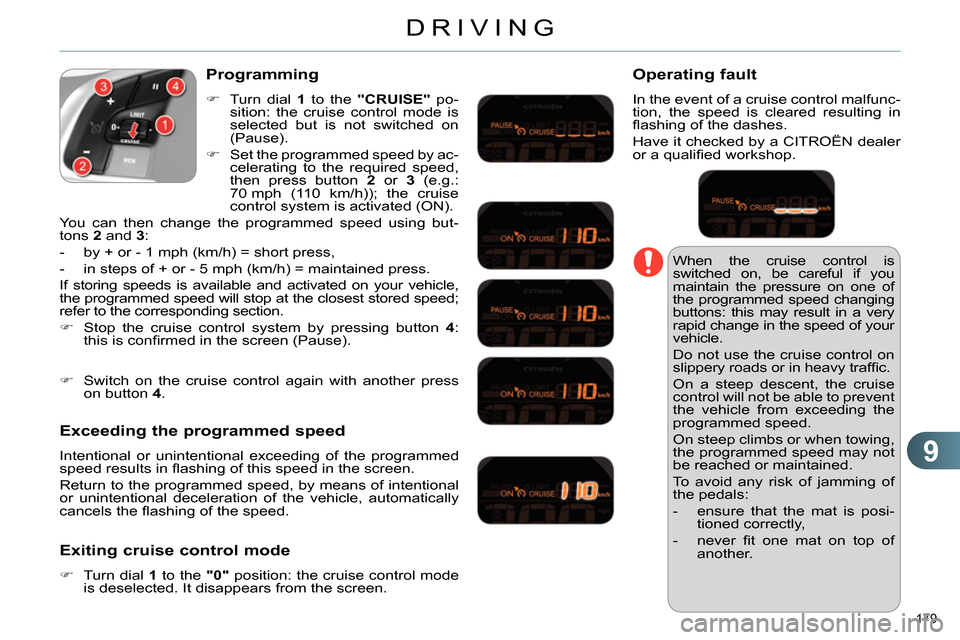
9
DRIVING
179
When the cruise control is
switched on, be careful if you
maintain the pressure on one of
the programmed speed changing
buttons: this may result in a very
rapid change in the speed of your
vehicle.
Do not use the cruise control on
slippery roads or in heavy traffi c.
On a steep descent, the cruise
control will not be able to prevent
the vehicle from exceeding the
programmed speed.
On steep climbs or when towing,
the programmed speed may not
be reached or maintained.
To avoid any risk of jamming of
the pedals:
- ensure that the mat is posi-
tioned correctly,
- never fi t one mat on top of
another.
Programming
Turn dial 1
to the "CRUISE"
po-
sition: the cruise control mode is
selected but is not switched on
(Pause).
Set the programmed speed by ac-
celerating to the required speed,
then press button 2
or 3
(e.g.:
70 mph (110 km/h)); the cruise
control system is activated (ON).
You can then change the programmed speed using but-
tons 2
and 3
:
- by + or - 1 mph (km/h) = short press,
- in steps of + or - 5 mph (km/h) = maintained press.
If storing speeds is available and activated on your vehicle,
the programmed speed will stop at the closest stored speed;
refer to the corresponding section.
Stop the cruise control system by pressing button 4
:
this is confi rmed in the screen (Pause).
Exceeding the programmed speed
Intentional or unintentional exceeding of the programmed
speed results in fl ashing of this speed in the screen.
Return to the programmed speed, by means of intentional
or unintentional deceleration of the vehicle, automatically
cancels the fl ashing of the speed.
Exiting cruise control mode
Turn dial 1
to the "0"
position: the cruise control mode
is deselected. It disappears from the screen.
Switch on the cruise control again with another press
on button 4
.
Operating fault
In the event of a cruise control malfunc-
tion, the speed is cleared resulting in
fl ashing of the dashes.
Have it checked by a CITROËN dealer
or a qualifi ed workshop.
Page 185 of 340
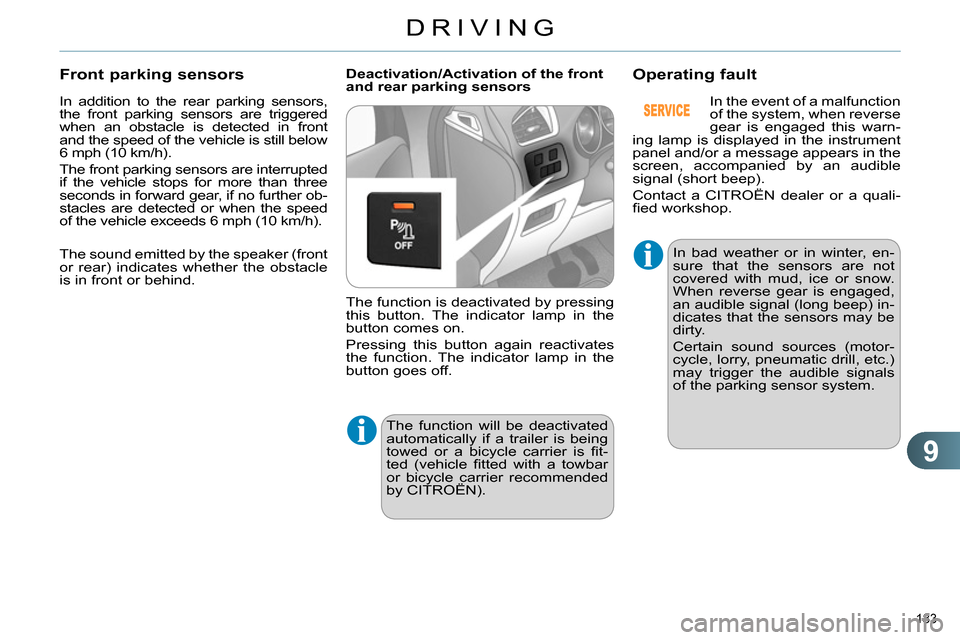
9
DRIVING
183
In addition to the rear parking sensors,
the front parking sensors are triggered
when an obstacle is detected in front
and the speed of the vehicle is still below
6 mph (10 km/h).
The front parking sensors are interrupted
if the vehicle stops for more than three
seconds in forward gear, if no further ob-
stacles are detected or when the speed
of the vehicle exceeds 6 mph (10 km/h).
Front parking sensors
Deactivation/Activation of the front
and rear parking sensors
The function is deactivated by pressing
this button. The indicator lamp in the
button comes on.
Pressing this button again reactivates
the function. The indicator lamp in the
button goes off.
Operating fault
The function will be deactivated
automatically if a trailer is being
towed or a bicycle carrier is fi t-
ted (vehicle fi tted with a towbar
or bicycle carrier recommended
by CITROËN).
In bad weather or in winter, en-
sure that the sensors are not
covered with mud, ice or snow.
When reverse gear is engaged,
an audible signal (long beep) in-
dicates that the sensors may be
dirty.
Certain sound sources (motor-
cycle, lorry, pneumatic drill, etc.)
may trigger the audible signals
of the parking sensor system.
In the event of a malfunction
of the system, when reverse
gear is engaged this warn-
ing lamp is displayed in the instrument
panel and/or a message appears in the
screen, accompanied by an audible
signal (short beep).
Contact a CITROËN dealer or a quali-
fi ed workshop.
The sound emitted by the speaker (front
or rear) indicates whether the obstacle
is in front or behind.
Page 186 of 340
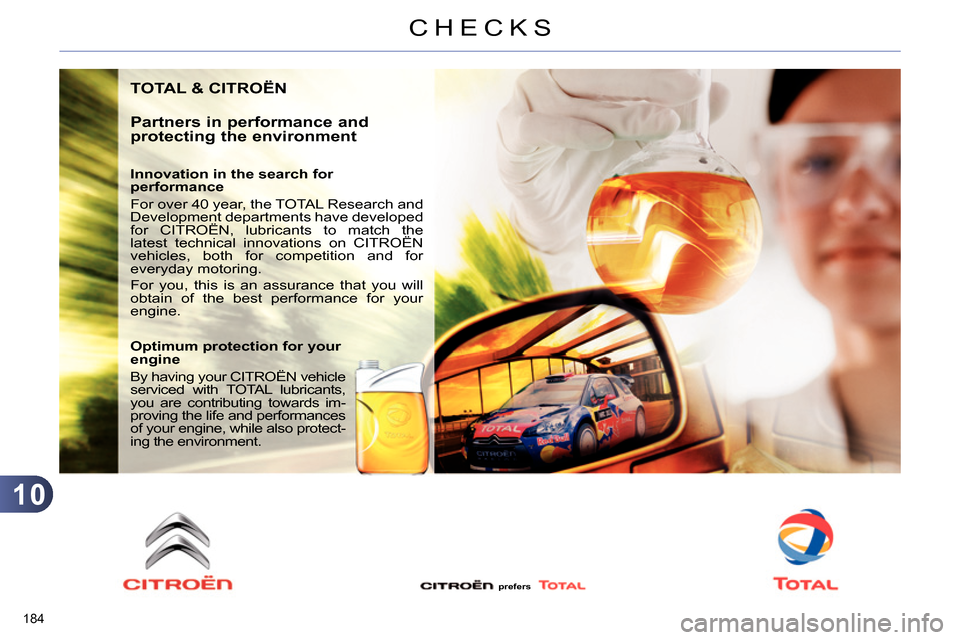
10
CHECKS
184
TOTAL & CITROËN
Partners in performance and
protecting the environment
Innovation in the search for
performance
For over 40 year, the TOTAL Research and
Development departments have developed
for CITROËN, lubricants to match the
latest technical innovations on CITROËN
vehicles, both for competition and for
everyday motoring.
For you, this is an assurance that you will
obtain of the best performance for your
engine.
Optimum protection for your
engine
By having your CITROËN vehicle
serviced with TOTAL lubricants,
you are contributing towards im-
proving the life and performances
of your engine, while also protect-
ing the environment.
prefers
Page 194 of 340
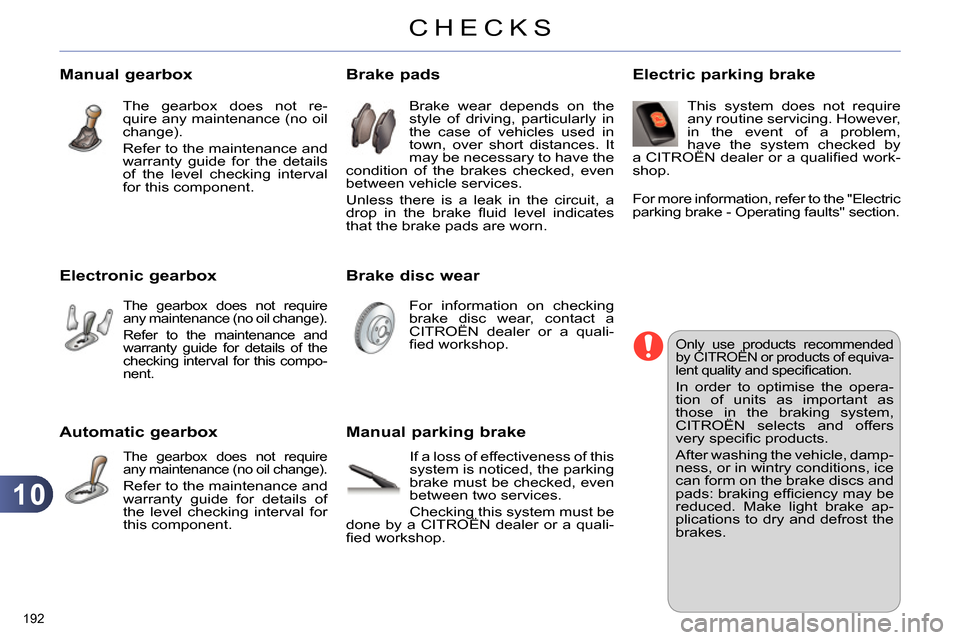
10
CHECKS
192
Automatic gearbox
The gearbox does not require
any maintenance (no oil change).
Refer to the maintenance and
warranty guide for details of
the level checking interval for
this component.
Electric parking brake
This system does not require
any routine servicing. However,
in the event of a problem,
have the system checked by
a CITROËN dealer or a qualifi ed work-
shop.
Manual parking brake
Only use products recommended
by CITROËN or products of equiva-
lent quality and specifi cation.
In order to optimise the opera-
tion of units as important as
those in the braking system,
CITROËN selects and offers
very specifi c products.
After washing the vehicle, damp-
ness, or in wintry conditions, ice
can form on the brake discs and
pads: braking effi ciency may be
reduced. Make light brake ap-
plications to dry and defrost the
brakes.
If a loss of effectiveness of this
system is noticed, the parking
brake must be checked, even
between two services.
Checking this system must be
done by a CITROËN dealer or a quali-
fi ed workshop.
Brake pads
Brake wear depends on the
style of driving, particularly in
the case of vehicles used in
town, over short distances. It
may be necessary to have the
condition of the brakes checked, even
between vehicle services.
Unless there is a leak in the circuit, a
drop in the brake fl uid level indicates
that the brake pads are worn.
Brake disc wear
For information on checking
brake disc wear, contact a
CITROËN dealer or a quali-
fi ed workshop.
For more information, refer to the "Electric
parking brake - Operating faults" section.
Manual gearbox
The gearbox does not re-
quire any maintenance (no oil
change).
Refer to the maintenance and
warranty guide for the details
of the level checking interval
for this component.
Electronic gearbox
The gearbox does not require
any maintenance (no oil change).
Refer to the maintenance and
warranty guide for details of the
checking interval for this compo-
nent.
Page 198 of 340
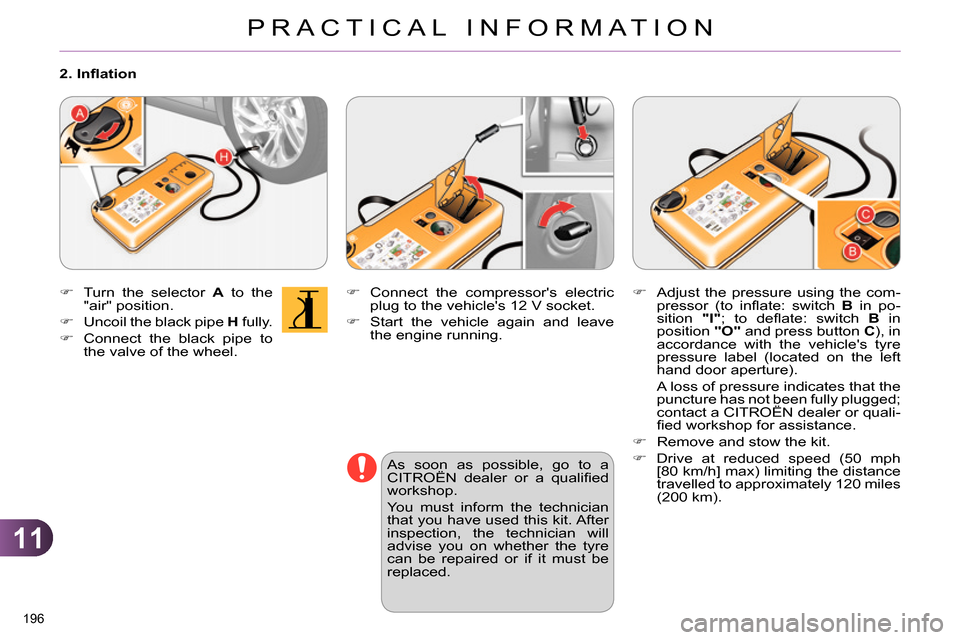
11
PRACTICAL INFORMATION
196
Connect the compressor's electric
plug to the vehicle's 12 V socket.
Start the vehicle again and leave
the engine running.
As soon as possible, go to a
CITROËN dealer or a qualifi ed
workshop.
You must inform the technician
that you have used this kit. After
inspection, the technician will
advise you on whether the tyre
can be repaired or if it must be
replaced.
Turn the selector A
to the
"air" position.
Uncoil the black pipe H
fully.
Connect the black pipe to
the valve of the wheel.
2. Infl ation
Adjust the pressure using the com-
pressor (to infl ate: switch B
in po-
sition "I"
; to defl ate: switch B
in
position "O"
and press button C
), in
accordance with the vehicle's tyre
pressure label (located on the left
hand door aperture).
A loss of pressure indicates that the
puncture has not been fully plugged;
contact a CITROËN dealer or quali-
fi ed workshop for assistance.
Remove and stow the kit.
Drive at reduced speed (50 mph
[80 km/h] max) limiting the distance
travelled to approximately 120 miles
(200 km).
Page 199 of 340

11
PRACTICAL INFORMATION
197
Removing the cartridge
Stow the black pipe.
Detach the angled base from the
white pipe.
Support the compressor vertically.
Unscrew the cartridge from the bottom.
Connect the compressor's electri-
cal connector to the vehicle's 12 V
socket.
Start the vehicle and let the engine
run.
Adjust the pressure using the com-
pressor (to infl ate: switch B
in po-
sition "I"
; to defl ate: switch B
in
position "O"
and press button C
),
according to the vehicle's tyre pres-
sure label or the accessory's pres-
sure label.
Remove the kit then stow it.
Beware of discharges of fl uid.
The expiry date of the fl uid is in-
dicated on the cartridge.
The sealant cartridge is designed
for single use; even if only partly
used, it must be replaced.
After use, do not discard the car-
tridge into the environment, take
it to an authorised waste dispos-
al site or a CITROËN dealer.
Do not forget to obtain a new
sealant cartridge, available from
CITROËN dealers or from a
qualifi ed workshop.
Checking tyre pressures /
inflating accessories
You can also use the compressor, with-
out injecting any product, to:
- check or adjust the pressure of your
tyres,
- infl ate other accessories (balls, bi-
cycle tyres...).
Turn the selector A
to the
"Air" position.
Uncoil the black pipe H
fully.
Connect the black pipe to
the valve of the wheel or accessory.
If necessary, fi t one of the adaptors
supplied with the kit fi rst.
Page 200 of 340

11
PRACTICAL INFORMATION
198
CHANGING A WHEEL
Procedure for changing a faulty wheel
for the spare wheel using the tools pro-
vided with the vehicle.
Access to the tools
The tools are installed in the boot under
the fl oor.
To gain access to them:
open the boot,
raise the fl oor,
secure it by hooking its cord on the
hook on the rear shelf support,
with a standard size spare wheel,
unclip and remove the box in the
middle of the wheel containing the
tools,
or
with a "space-saver" spare wheel;
lift the wheel at the rear towards you
for access to the storage box con-
taining the tools.
List of tools
All of these tools are specifi c to your
vehicle. Do not use them for other pur-
poses.
1.
Wheelbrace.
For removing the wheel trim and
the wheel fi xing bolts.
2.
Jack with integral handle.
For raising the vehicle.
3.
"Bolt cover" tool.
For removing the bolt protectors
(covers) on alloy wheels.
4.
Socket for the security bolts (lo-
cated in the glove box).
For adapting the wheelbrace to the
special "security" bolts.
Wheel with trim
When removing the wheel
, detach the trim fi rst using the wheelbrace 1
pulling at the valve passage hole.
When refi tting the wheel
, refi t the trim starting by placing its notch facing
the valve and press around its edge with the palm of your hand.